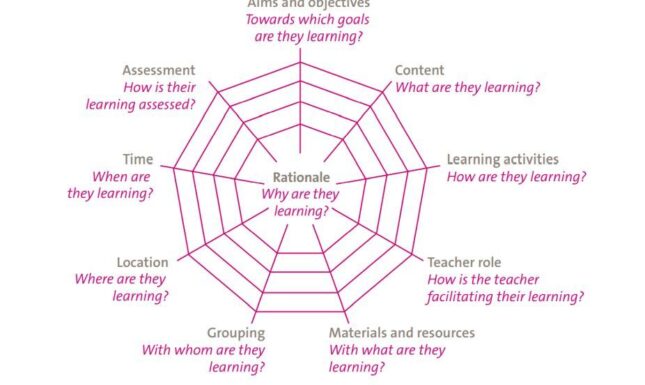Of Classics and Curricular Cobwebs: Towards the Development of Interdisciplinary Teaching in Dutch Gymnasia
One would expect interdisciplinary learning to be an essential component of the curricula in secondary schools in The Netherlands. Unfortunately, according to latest reports, it is not. In this blog post, Sandra Karten explains the advantages and challenges of interdisciplinary teaching.
'Imagine for the moment that we are confronted with some problem or puzzling situation in our lives. How do we approach the situation? Do we stop and ask ourselves which part of the situation is language, arts, or music, or mathematics, or history, or art?'
This is the question James Beane poses in his book on curriculum integration (1997). His answer, and I am pretty sure the essence of the answer of most of you reading this is: ‘I don’t think so.’
Beane directs us towards one of the many advantages of interdisciplinary teaching: it prepares students for the way they need to handle real problems and situations in a real world and hence prepares them for the future. It also challenges them to think about the world from different perspectives and enhances higher order thinking, such as analyzing, reasoning and evaluating (Lattuca, Voigt, & Faith 2004). When considering all these advantages, one would expect interdisciplinary learning to be an essential component of the curricula in secondary schools in The Netherlands. Unfortunately, according to latest reports (the Curriculum Mirror 'Curriculumspiegel' of 2017), it is not.
One might certainly expect that interdisciplinary teaching in the Dutch gymnasium is a core component of the curriculum, since this is the place where Latin and Greek languages and culture are taught, subjects that are essentially multidisciplinary. Hence there are lots of topics and possibilities for interdisciplinary teaching. Although teachers have expressed their strong wishes to work together with other disciplines (e.g. in the report ‘Selfie with Sappho’) and initiatives to do so have been taken, interdisciplinary teaching still is not a prominent feature at many schools in The Netherlands (Belangengroep Gymnasiale vorming 2015, 2020). Moreover, a didactical model for interdisciplinary teaching in gymnasia, that aids educators in designing their teaching activities, has not yet been developed. There seems to be a gap between the intended curriculum (our ‘dreams’, so to say) and the implemented curriculum (the ‘deeds’). My research project, supervised by prof. dr. Casper de Jonge (LUCAS) and dr. Lidewij van Gils (University of Amsterdam) and subsidized by DUDOC-ALFA, aims at bridging that gap by developing design criteria for successful interdisciplinary teaching in Dutch gymnasia.
But first: I mentioned the term curriculum already a few times, but haven’t given a clear definition of what is meant by this word when used in an educational context. I have already come across many definitions (all more or less deriving their meaning from the Latin currere, ‘to run’), but one of the most clear ones is the very short, not so new, definition by Hilda Taba (1962): a ‘plan for learning’. Jan van den Akker, who has written a lot about curriculum development, both in Dutch and in English, distinguishes between the intended and implemented curriculum, as mentioned above. He also emphasizes the difference between various levels of this ‘plan for learning’ (van den Akker 2013). He makes a distinction between the macro level (e.g. national syllabi and core objectives), the meso level (e.g. school-specific curriculum) and the micro level (e.g. textbooks and instructional materials).
Apart from the various levels of a curriculum it can be helpful to investigate the different components therein. Traditionally much attention is given to the content of a learning plan. But, as the earlier mentioned Jan van den Akker points out, a lot more components than just content play a part in developing a balanced and consistent curriculum. He uses the metaphor of a ‘cobweb’ to illustrate how ten different components are all important, connected and vulnerable when developing and improving a curriculum, as seen in Figure 1.


Let me give a few examples of how the different components of Figure 1 each play an important part in developing a curriculum.
Pupils who graduated from Dutch gymnasia often list one thing as the highlight of their high school carrier: the trip to Rome or Greece (at many secondary school organized in the 5th year). Considering the curriculum spider’s web in this case the component ‘Location (where are they learning?)’ is of utmost importance in the plan for learning. The learning does not take place in the ‘usual classroom’, but far away from it, abroad, in an environment unknown to pupils. The location is connected closely to the ‘Materials and resources’ (with what are they learning?), since pupils while travelling aren’t learning from text books and powerpoint presentations, but by standing next to and examining impressive ancient temples. This fact alone asks for different kinds of ‘Learning activities’ (how are they learning?). And all of this has to do with the ‘Rationale’ in the centre of the web: why do many teachers of Classics see this trip as valuable and as a core element of the gymnasium curriculum?
Another fascinating component of a curriculum is ‘Time’ (when are they learning?). I think we can all agree that teaching (or taking!) a class on Monday morning feels very different than on Friday afternoon and may influence what and how one learns. Returning to the topic of interdisciplinary teaching, the component ‘time’ holds an interesting place in my research so far. Often interdisciplinary learning in secondary schools is organized in so-called project weeks, in which pupils don’t take any regular classes, but work on one interdisciplinary topic throughout the week. This was for instance the case at a recent interdisciplinary project set up at the school at which I am a part-time teacher, with my colleagues of Classics, Dutch, Arts, Biology, History and Religious Studies. The project, titled ‘More heroes needed’, was developed for second year students and invited pupils to explore ‘heroes’ through the ages and to reflect on who they considered as heroes and why. Setting up a project in a separate week creates all kinds of possibilities for alternative grouping and learning activities. It also comes with challenges: cancelling regular classes may create the feeling that interdisciplinary learning is in fact something extracurricular, which has nothing to do with what pupils are already learning. This is illustrated by the following: when we asked pupils about their experiences during the project, one pupil answered: ‘Yes, I enjoyed myself. But I didn’t learn anything’.
So this leaves us with one vital question: how can teachers in Dutch gymnasia design interdisciplinary teaching successfully? That is exactly the question I hope to answer in the following years while conducting my research project. A project I hope to develop not only together with the teachers of today, but also for the teachers of tomorrow.
References
Akker, J. v.d. (2013). Curricular Development Research as a Specimen of Educational Design Research. In Plomp, T. & Nieveen, N. (Eds.), Educational Design Research Part A: an Introduction, 52-71. Enschede: SLO.
Beane, J. A. (1997). Curriculum Integration: Designing the Core of a Democratic Education. New York: Teachers College Press.
BGV/AOb. (2015). Enquête Stand van de Gouden Standaard voor gymnasiumopleiding op de scholengemeenschappen. Utrecht: BGV / AOb.
BGV/AOb. (2020). Rapportage BGV-conferentie 28 november 2019 Het 13e werk van Herakles: voortbouwen op bouwstenen. Utrecht: BGV / AOb.
Folmer, E., Koopmans-van Noorel, A. & Kuiper, W. (2017). Curriculumspiegel 2017. Enschede: SLO.
Lattuca, L., Voigt, L., & Fath, K. (2004). Does interdisciplinarity promote learning? Theoretical support and researchable questions. Review of Higher Education, 23-48.
Taba, H. (1962). Curriculum development: Theory and practice. New York: Harcourt, Brace & World.
VCN-Volgteam. (2019). Selfie met Sappho. Utrecht: VCN.
© Sandra Karten and Leiden Arts in Society Blog, 2021. Unauthorised use and/or duplication of this material without express and written permission from this site’s author and/or owner is strictly prohibited. Excerpts and links may be used, provided that full and clear credit is given to Sandra Karten and Leiden Arts in Society Blog with appropriate and specific direction to the original content.



0 Comments